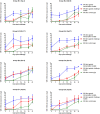The Ability of Porcine Reproductive and Respiratory Syndrome Virus Isolates to Induce Broadly Reactive Neutralizing Antibodies Correlates With In Vivo Protection
- PMID: 34381448
- PMCID: PMC8350477
- DOI: 10.3389/fimmu.2021.691145
The Ability of Porcine Reproductive and Respiratory Syndrome Virus Isolates to Induce Broadly Reactive Neutralizing Antibodies Correlates With In Vivo Protection
Abstract
Porcine reproductive and respiratory syndrome (PRRS) is considered one of the most relevant diseases of swine. The condition is caused by PRRS virus (PRRSV), an extremely variable virus of the Arteriviridae family. Its heterogeneity can be responsible, at least partially, of the poor cross-protection observed between PRRSV isolates. Neutralizing antibodies (NAs), known to play a role in protection, usually poorly recognize heterologous PRRSV isolates, indicating that most NAs are strain-specific. However, some pigs develop broadly reactive NAs able to recognize a wide range of heterologous isolates. The aim of this study was to determine whether PRRSV isolates that induce broadly reactive NAs as determined in vitro are able to confer a better protection in vivo. For this purpose two in vivo experiments were performed. Initially, 40 pigs were immunized with a PRRSV-1 isolate known to induce broadly reactive NAs and 24 additional pigs were used as controls. On day 70 after immunization, the pigs were divided into eight groups composed by five immunized and three control pigs and exposed to one of the eight different heterologous PRRSV isolates used for the challenge. In the second experiment, the same experimental design was followed but the pigs were immunized with a PRRSV-1 isolate, which is known to generate mostly strain-specific NAs. Virological parameters, specifically viremia and the presence of challenge virus in tonsils, were used to determine protection. In the first experiment, sterilizing immunity was obtained in three groups, prevention of viremia was observed in two additional groups, although the challenge virus was detected occasionally in the tonsils of immunized pigs, and partial protection, understood as a reduction in the frequency of viremia compared with controls, was recorded in the remaining three groups. On the contrary, only partial protection was observed in all groups in the second experiment. The results obtained in this study confirm that PRRSV-1 isolates differ in their ability to induce cross-reactive NAs and, although other components of the immune response might have contributed to protection, pigs with cross-reactive NAs at the time of challenge exhibited better protection, indicating that broadly reactive NAs might play a role in protection against heterologous reinfections.
Keywords: broad neutralization; cross-protection; in vivo protection; neutralizing antibody; porcine reproductive and respiratory syndrome virus.
Copyright © 2021 Martínez-Lobo, Díez-Fuertes, Simarro, Castro and Prieto.
Conflict of interest statement
The authors declare that the research was conducted in the absence of any commercial or financial relationships that could be construed as a potential conflict of interest.
Figures




References
-
- International Committee of Virus Taxonomy . Virus Taxonomy: 2019 (2019). Available at: https://talk.ictvonline.org/taxonomy/ (Accessed March 1, 2021).
Publication types
MeSH terms
Substances
LinkOut - more resources
Full Text Sources

